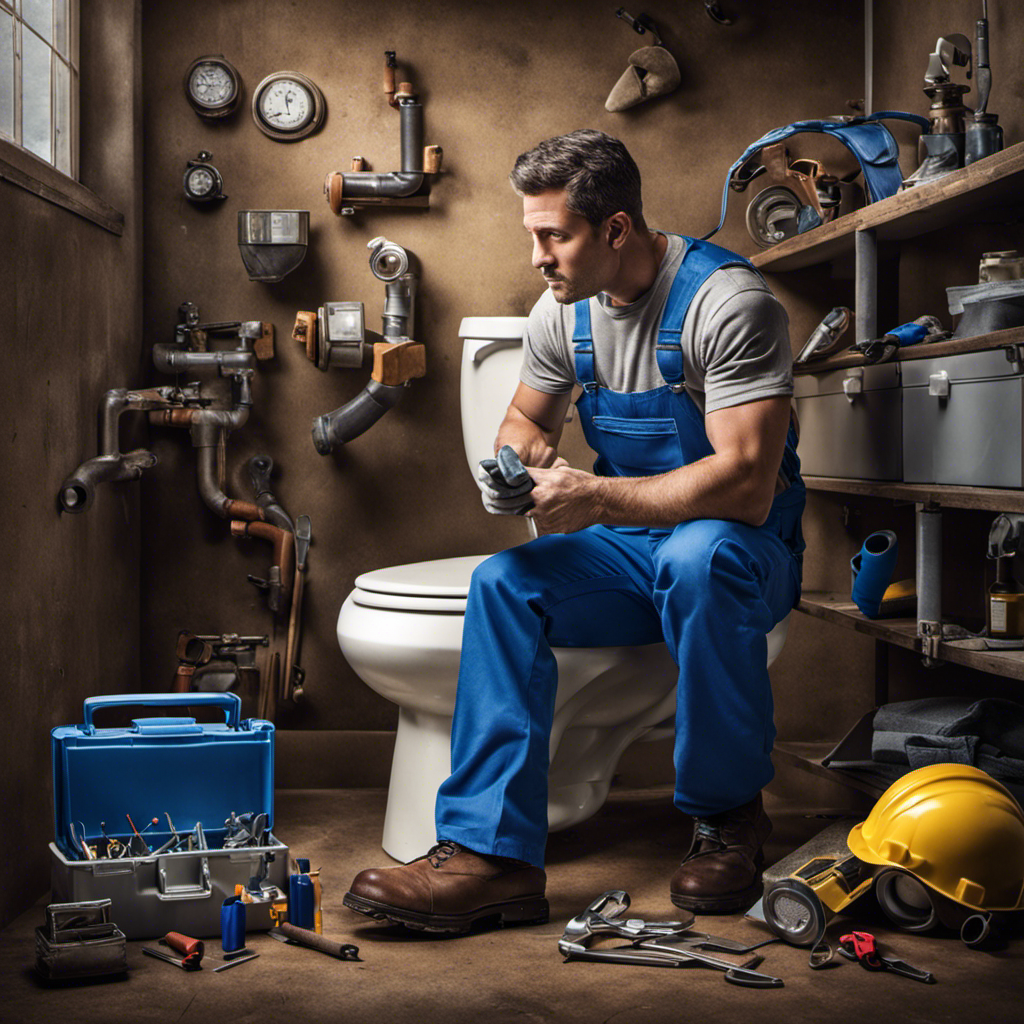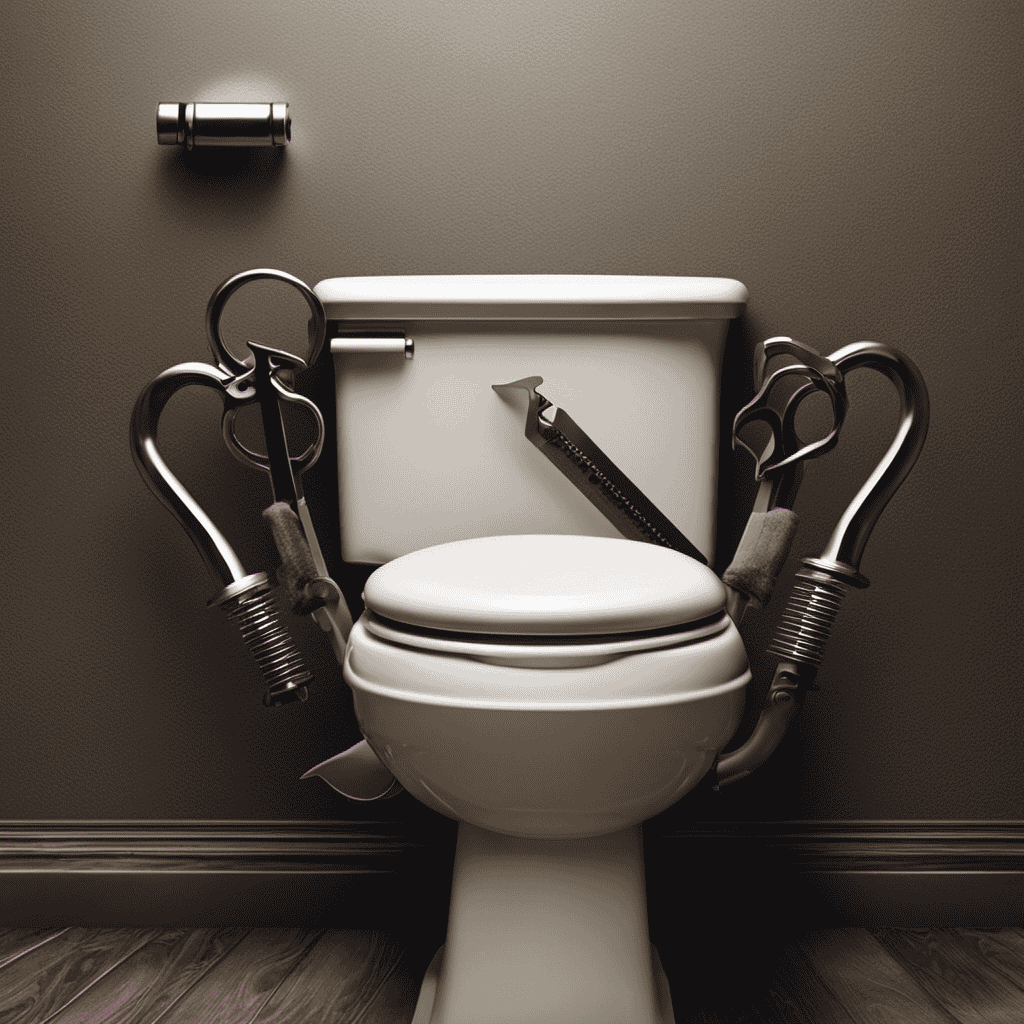Did you know that 90% of clogged toilets can be unclogged without the use of a plunger? That’s right, you don’t have to panic when faced with a toilet blockage anymore.
In this article, I will guide you through the step-by-step process of unclogging a toilet using alternative methods. From natural remedies to household items, chemical solutions to mechanical tricks, I will provide you with a range of options to tackle this common household problem.
So, let’s get started and regain control of your clogged toilet!
Key Takeaways
- Natural methods such as using baking soda and vinegar or hot water and dish soap can effectively unclog a toilet without a plunger.
- Household items like a wire hanger, wet/dry vacuum, or plastic bottle can be used as alternative tools for unclogging a toilet.
- Chemical solutions should be used as a last resort and with caution, following the manufacturer’s instructions and wearing protective gear.
- If all else fails, consider using a toilet auger or calling a professional plumber for assistance. Regular toilet maintenance and proper flushing habits can help prevent future clogs.
Understanding the Problem
First, you’ll need to understand why your toilet is clogged in order to effectively unclog it without a plunger.
There are several common causes for a clogged toilet, such as excessive toilet paper, foreign objects, or a buildup of waste material.
To troubleshoot the issue, start by checking if there is any visible blockage near the surface of the toilet bowl. If so, you can try using a toilet snake or a wire hanger to dislodge the blockage.
Another troubleshooting tip is to pour hot water into the toilet bowl and let it sit for a few minutes before flushing. This can help break down the blockage and allow it to pass through the pipes.
Remember to be cautious and avoid using chemicals or sharp objects that could damage the toilet or pipes.
Gathering the Necessary Supplies
Once you’ve got everything you need, it’s time to tackle the clogged toilet. Here are the essential supplies you should gather before starting the process:
- Rubber gloves: Protect your hands from any potential contamination.
- Bucket: Use it to hold water or remove excess water from the toilet bowl.
- Hot water: Pouring hot water into the toilet can help break down the clog.
- Dish soap: Adding a few squirts of dish soap can lubricate the pipes and aid in unclogging.
- Plumbing snake: This tool is essential for physically dislodging the blockage.
Plumbing emergencies can be stressful, but with the right supplies and techniques, you can handle them effectively. Regular toilet maintenance is crucial to prevent clogs in the first place. Remember to avoid flushing non-flushable items and consider using a toilet plunger regularly to keep your toilet in good working order.
Applying Natural Methods
To tackle a clogged toilet without using a plunger, you can try applying natural methods. These natural remedies are not only effective but also eco-friendly solutions. Here’s a table outlining three natural methods you can try:
| Natural Method | Ingredients | Instructions |
|---|---|---|
| Baking Soda and Vinegar | 1 cup baking soda, 2 cups vinegar | 1. Pour the baking soda into the toilet bowl. |
- Add the vinegar and let it sit for 30 minutes.
- Flush the toilet to see if the clog has cleared. |
| Hot Water and Dish Soap | Hot water, dish soap | 1. Pour a generous amount of dish soap into the toilet bowl. - Boil water and carefully pour it into the bowl.
- Let it sit for a few minutes.
- Flush the toilet to see if the clog has cleared. |
| Wire Hanger | Wire hanger | 1. Straighten the wire hanger, leaving a small hook at one end. - Insert the hook end into the toilet drain.
- Wiggle and push the hanger to dislodge the clog.
- Flush the toilet to see if the clog has cleared. |
These natural methods can be effective in unclogging your toilet without the need for a plunger. Give them a try and see which one works best for you. Remember to always follow the instructions carefully and consider the eco-friendly aspect of these solutions.
Using Household Items as Tools
Using household items as tools can be an effective way to tackle a clogged toilet. When faced with a toilet blockage, it’s important to think outside the box and utilize unconventional techniques. Here are five resourceful household hacks that can help you unclog a toilet without a plunger:
-
Hot Water and Dish Soap: Pour a generous amount of dish soap into the toilet bowl, followed by hot water. Let it sit for a few minutes before flushing.
-
Baking Soda and Vinegar: Mix equal parts baking soda and vinegar and pour it into the toilet bowl. Allow it to sit for about 10 minutes, then flush.
-
Wire Hanger: Straighten out a wire hanger and use it to break up the clog by gently pushing and twisting it through the drain.
-
Wet/Dry Vacuum: Use a wet/dry vacuum to suck out the water and the clog from the toilet bowl.
-
Plastic Bottle: Cut off the bottom of a plastic bottle to create a makeshift plunger. Place it over the drain and push down firmly to create suction.
Employing Chemical Solutions
Don’t forget, there are chemical solutions available that can help you quickly dissolve and remove toilet clogs. When facing a stubborn clog, chemical alternatives can be effective in breaking down the blockage.
However, it is important to take safety precautions when using these solutions. Always read the instructions carefully and wear protective gloves and eyewear. Chemicals like drain cleaners contain strong ingredients that can cause skin irritation or burns. Make sure to keep them out of reach of children and pets. Additionally, avoid mixing different types of chemicals as this can lead to dangerous reactions.
Remember, chemical solutions should be used as a last resort and in accordance with the manufacturer’s instructions.
Now, let’s explore employing mechanical solutions to tackle your toilet clog.
Employing Mechanical Solutions
When it comes to unclogging a toilet, sometimes a plunger may not be readily available or may not be effective. In such situations, alternative toilet unclogging methods can come in handy.
In this discussion, I will explore simple DIY solutions that can be used as effective alternatives to unclog a toilet without the need for a plunger.
Alternative Toilet Unclogging Methods
If you’re looking for alternative methods to unclog your toilet without a plunger, you can try using a combination of hot water and dish soap. This emergency unclogging technique is a non-traditional toilet fix that can be effective in certain situations.
Here are five other alternative methods you can try:
- Using a wire hanger to manually remove the clog
- Pouring baking soda and vinegar down the toilet to create a fizzy reaction
- Using a wet/dry vacuum to suck out the clog
- Using a toilet auger to break up the blockage
- Trying a natural enzyme-based cleaner to dissolve the clog
Simple DIY Solutions
To effectively address the clog in your toilet, a simple DIY solution is to use a mixture of baking soda and vinegar. This combination creates a chemical reaction that helps break down the blockage and unclog the toilet.
Start by pouring half a cup of baking soda into the toilet bowl. Then, slowly pour one cup of vinegar into the bowl as well. The mixture will start to fizz and bubble, which is a good sign that it is working.
Let the mixture sit for about 30 minutes to allow it to work its magic. Finally, flush the toilet to see if the clog has been cleared. This method is one of the most effective remedies for unclogging toilets without using a plunger.
Preventing Future Clogs
One way to prevent future clogs is by regularly maintaining your toilet. By following a few simple steps, you can ensure that your toilet stays in good working condition and avoid costly repairs or inconvenience.
Here are five important things to keep in mind when it comes to toilet maintenance and proper flushing:
- Regularly clean your toilet bowl using a toilet brush and cleaning solution to remove any buildup or residue.
- Avoid flushing excessive amounts of toilet paper or other non-flushable items down the toilet.
- Use the appropriate amount of water when flushing, as too little water can result in incomplete flushing and potential clogs.
- Check the flushing mechanism and ensure it is working properly, adjusting or repairing it as needed.
- Consider installing a toilet auger to have on hand for any minor clogs that may arise.
Frequently Asked Questions
Can I Use a Plunger if I Have One Available?
If a plunger is available, it can be used to unclog a toilet. However, if it’s not an option, there are alternative tools like a toilet auger or drain snake. Natural methods can also be attempted before resorting to a plunger.
How Long Does It Usually Take for Natural Methods to Work?
I can’t say for sure how long it usually takes for natural methods to work, but they can be effective. Some alternatives to a plunger include using hot water, dish soap, or a toilet auger.
Are There Any Specific Household Items That Should Not Be Used as Tools?
Using household items to unclog a toilet can be convenient, but it’s important to be cautious. Some items, such as wire hangers or chemical drain cleaners, can damage the plumbing and pose health risks.
What Are the Common Side Effects of Using Chemical Solutions?
Common dangers and health risks of using chemical solutions include skin irritation, respiratory problems, and eye damage. It is essential to exercise caution and follow safety guidelines to avoid these potential side effects.
How Often Should I Perform Preventive Measures to Avoid Future Clogs?
To avoid future clogs, I need to perform preventive maintenance regularly. The frequency of preventive measures depends on factors such as usage and the condition of the plumbing system.
Conclusion
In conclusion, it is entirely possible to unclog a toilet without a plunger with the right techniques and tools. By understanding the problem and gathering the necessary supplies, you can effectively tackle the issue.
Natural methods such as using hot water or baking soda and vinegar can work wonders. Additionally, household items like a wire coat hanger or a wet/dry vacuum can be utilized as tools to remove the clog.
Chemical solutions and mechanical solutions like toilet augers can also be employed if needed. By taking these steps and being proactive in preventing future clogs, you can maintain a smoothly functioning toilet.










